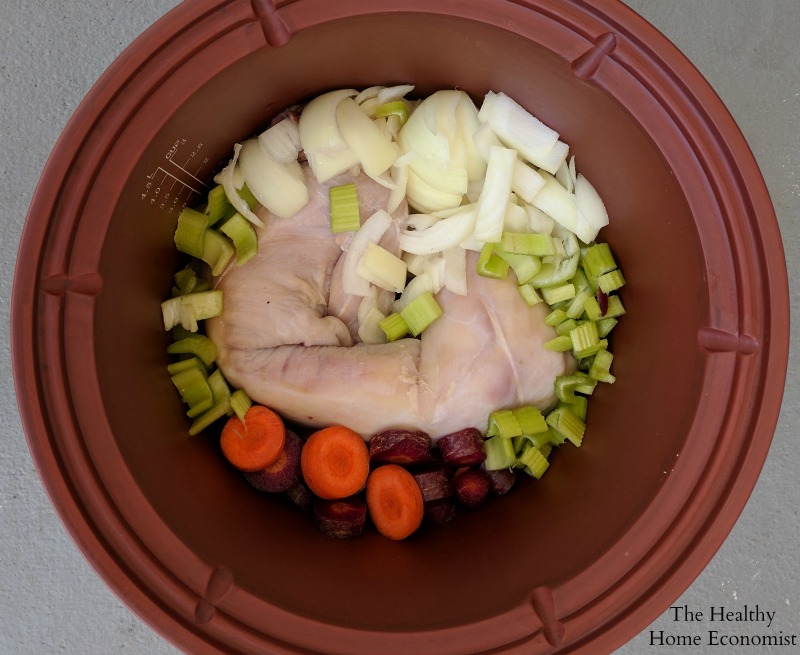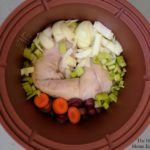
Rabbit is not a very popular meat in the United States. In Europe, however, it is commonplace with numerous traditional recipes in German, French and Italian cuisine. Where there are rabbit recipes, there is also rabbit bone broth as our forebears frugally used the whole animal for food. This was in keeping with the 1546 proverb, “Willful waste makes woeful want” and a similar saying first recorded in 1772, “Waste not want not“.
The popularity of rabbit as an environmentally friendly meat source is causing a significant change, however. Rabbit, which is all white meat, is starting to gain some serious traction on North American dinner plates.
Easy to raise, butcher and prepare, rabbits don’t need large tracts of land upon which to roam and graze. The average sized rabbit produces 6 pounds of meat on the same amount of food and water it takes a cow to produce 1 pound!
We all know that rabbits reproduce, well, like rabbits! They’re ready to eat in 10 weeks and super tasty too (like chicken!).
For these reasons, rabbit is becoming more widely available where just a few years ago you couldn’t find them anywhere unless you raised them yourself. In my local area, for example, rabbit is regularly available at both of the butcher shops closest to my home.
Rabbit Bone Broth
If your family absolutely won’t eat rabbit, the best way to ease them into acceptance is with rabbit bone broth. It tastes just like chicken bone broth, and so you can use it for all your soup and sauce recipes.
Once the kids have seen Mom or Dad buy rabbit a few times and make broth with it, they will be more open to eating it. This recipe for rabbit Moroccan hot pot is an easy one to try first when you get to that point.
Below is a recipe for basic rabbit bone broth. Try it! While not the most nutritious bone broth made from fish, you will be amazed how inexpensive rabbit stock is to make compared with pastured chicken broth while tasting essentially the same with a similar nutritional profile.
This article on simmering bone broth shows the perfect roll that isn’t too high and isn’t too low. Also, if your broth doesn’t properly become a semi-solid once refrigerated, refer to this guide on the 5 most common reasons broth won’t gel.
If you are sensitive to monosodium glutamate, I would recommend reading this article on MSG in bone broth.
Best Cookware for Bone Broth
As you can see from the photo above, I use a large, 4.5 quart Vita-Clay to make my bone broth. I prefer a clay pot to a stockpot or a pressure cooker because of the acidity of bone broth, which has the potential to leech nickel and excessive chromium from stainless steel. This article on stainless steel cookware explains the research studies that give rise to this very real concern.
Another benefit of using a slow cooker like the Vita-Clay (which is periodically offered in stoneware as well as clay) is that you can leave it gurgling while you leave the house. It’s also safe and eliminates the fire danger from a simmering pot on the stovetop while the household is asleep at night.

Rabbit Bone Broth Recipe
Easy recipe for rabbit stock that is frugal and compares favorably in flavor to broth from pastured chickens or grassfed beef.
Ingredients
- 1 whole rabbit preferably pastured, innards removed
- filtered water
- 2-3 Tbl apple cider vinegar preferably raw, organic and packed in glass bottles
- 3 cups chopped vegetables preferably onion, carrots, and celery
Instructions
-
Place whole rabbit and vegetables in a large pot and fill with filtered water.
-
Stir in vinegar while bringing the water to a gentle boil.
-
As the water first begins to boil, skim off any foam that rises to the surface. It is important to remove this foam as this is impurities and off flavors.
-
Reduce heat to a simmer for 24 hours.
-
Cool and then strain into containers for refrigeration.
-
Freeze what you will not use in one week.








Growing up we raised rabbits for “pets”. We always seemed to be eating “chicken” but I could never get a wing because my mom always said they ran out. lol Our family started calling it “city chicken” because there were no wings. Years later it turns out it wasn’t chicken after all, but rabbit. My husband nad I now raise rabbits for meat and quite enjoy their taste.
Thanks Sarah! That is helpful! I will try that! What do you do if you ever want to leave it on overnight since you couldn’t be changing it’s settings?
It will run on warm for up to 9 hours, so just set to warm for 5 hours when you go to bed and then it will automatically go to warm until you get up. Then reset. I don’t max it out on 9.5 hours overnight in case it needs to be topped up with water. 5 hours is safe and it will still be quite hot when you get up so just reset to low at that time.
So I just got a Vita Clay to make my bone broth and am super excited! I have put everything into my clay cooker and pressed ‘Slow.’. This has got my broth at a great boil, but I am wondering how many hours you let it boil on the ‘slow’ setting? Then do you just switch it to ‘Warm’ to keep it at a simmer for the extended period of time? Would love your experience on how to make the best broth in this cooker! Thanks!
That’s awesome! What I do is cook on slow for 5 hours and then on warm for 1 hour and then back to 5 hours on slow and 1 hour on warm. I do this one more time if I can and then strain.